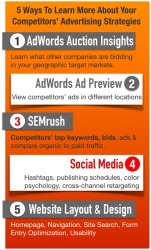 When it comes to online advertisement, it is essential to have a solid and scalable marketing strategy in place.
When it comes to online advertisement, it is essential to have a solid and scalable marketing strategy in place.
At the same time, one of the main characteristics of SEM is that the efforts of your competitors influence the performance of your online campaigns more than with traditional marketing methods. Thus, in order to beat your competitors, you must first of all know what their strategies are. Ideally, you even connect the dots between ads, bids, landing pages and social media accounts.
There are multiple ways to learn more about your competitors’ advertising campaigns. Here are five I've used that are useful and effective.
1. AdWords Auction Insights
The Auction Insights Report can be retrieved within AdWords on a campaign or ad group level, and gives you valuable information on what other companies are bidding on your keywords in your geographic target markets. Additionally, it shows their impression share compared to your own, as well as how many times (in percentages) you and your competitors showed up on top of the page meaning above the fold.
While these insights can be helpful, they can easily be misinterpreted. For instance, the impression share of a large global business and a small local business might differ significantly. So might the reasons for advertising. Not all companies are looking for straight-forward conversions on AdWords, or have large budgets for brand campaigns on the Google Search Network that result in a large impression share.
2. AdWords Ad Preview Tool
 The Google AdWords Ad Preview Tool is underestimated. The tool enables you to see ads of specific competitors and how ads of different competitors compare to each other and your own, at least on the first page of Google.
The Google AdWords Ad Preview Tool is underestimated. The tool enables you to see ads of specific competitors and how ads of different competitors compare to each other and your own, at least on the first page of Google.
Could you see that without the Ad Preview Tool if you were in the same location as your geographic target market? Absolutely. Could you see how your ad compared without this tool if you were not using Google in the area you were targeting? Of course not.
Here is where the Ad Preview Tool comes in. Many companies assume their competitors are only advertising where they are, but they might be mistaken — therefore missing out on the main function the tool provides: pretending to be somewhere else and viewing Google’s search results as someone else would in a different location.
3. SEMrush
SEMrush is useful for a wide variety of reasons, but especially when it comes to analyzing your competitors’ strategies on a keyword level.
When typing in a given keyword, the platform provides you with the top companies bidding on it, reveals their respective bids, and compares paid to organic traffic. The best part? SEMrush shows you those results for concrete competitors and allows you to track down the specific ad creatives, as well as the landing pages by inserting a URL.
Last but not least, this handy tool lets you know whether and which competitors are using display advertising.
4. Social Media
Nowadays, cross-channel advertising is becoming increasingly popular. Chances are your competitors are optimizing and integrating their advertising campaigns as you are reading this. One way to learn more about your competitors’ strategies is to analyze their social media efforts.
Hashtags, publishing times, channel art, color psychology and the percentage of original versus other people’s content all play a big part when it comes to social media strategies. By keeping track of social media activities, you can compare your own, and draw conclusions to your advantage.
5. Website Layout And Design
Mobile landing pages are easily overlooked when it comes to landing page analysis, opening up new opportunities for those who are thorough. As mentioned at the Google Partners All-Stars Summit 2014 at Google’s headquarters in Mountain View, California, mobile conversion rates are most influenced by the following five topics:
• Homepage and Navigation
• Site Search
• Commerce and Conversions
• Optimizing Form Entry
• Form Factor and Usability
A great example of a successful mobile layout and design is Progressive, the auto insurance company. Forms are optimized and above the fold, the navigation is short and easy to find, and the site search button is easily accessible and delivers excellent results, even with short search queries.
Instead of using responsive templates or designs, take the time to create a custom mobile site that incorporates small changes and, in return, generates more conversions. Some beginning changes could include mobile menus, visual calendars, forms above the fold, automatic zoom for form fields and real-time field error notifications.







